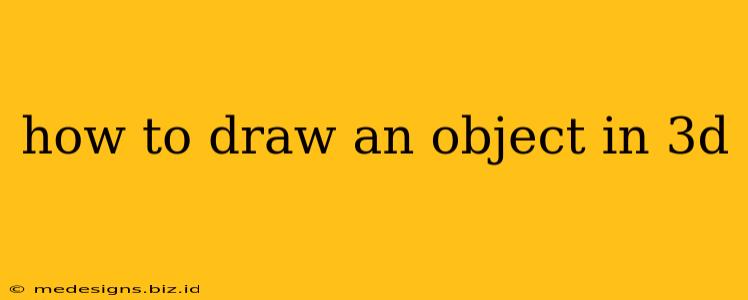Want to learn how to draw realistic 3D objects? This comprehensive guide will take you through the fundamental steps, from understanding perspective to mastering shading and adding depth. Whether you're a complete beginner or looking to improve your existing skills, this guide will help you create impressive 3D drawings.
Understanding Perspective: The Foundation of 3D Drawing
The key to making any object look three-dimensional is understanding perspective. Perspective is how objects appear to shrink as they get farther away from the viewer. There are several types of perspective, but for beginners, one-point perspective is a great place to start.
One-Point Perspective: A Simple Start
One-point perspective uses a single vanishing point on the horizon line. All lines that recede into the distance converge at this point. This makes it ideal for drawing objects like roads, buildings, or boxes from a straightforward viewpoint.
- Step 1: Draw the Horizon Line: This is a horizontal line representing your eye level.
- Step 2: Choose a Vanishing Point: Place a point on the horizon line where all receding lines will meet.
- Step 3: Draw the Object's Base: Start with the closest part of your object and draw its base shape.
- Step 4: Draw Lines to the Vanishing Point: From the corners of your base, draw light lines towards the vanishing point. These lines guide the receding sides of your object.
- Step 5: Complete the Object: Connect the lines to create the shape of your 3D object. Remember to maintain the perspective by keeping all parallel lines converging at your vanishing point.
Mastering Shading and Adding Depth
Once you've established the basic form using perspective, shading is crucial for bringing your drawing to life. Shading simulates the way light interacts with the object's surfaces, creating shadows and highlights that convey depth and volume.
Techniques for Realistic Shading
- Light Source: Identify a light source (e.g., sun, lamp). This determines where your highlights and shadows will fall.
- Highlights: The areas of your object directly facing the light source will receive the most light, creating highlights.
- Midtones: The areas in between the highlights and shadows.
- Shadows: The areas shielded from the light source will cast shadows, adding depth and form.
- Cast Shadows: The shadow cast by the object onto the surface it rests on.
Experiment with different shading techniques: hatching, cross-hatching, and blending can all create varying levels of shadow and detail.
Choosing Your Subject and Practice
Practicing regularly is essential to improving your 3D drawing skills. Start with simple objects like cubes, spheres, and cylinders before moving onto more complex forms. Observe real-world objects carefully – pay attention to their proportions, shapes, and how light falls on their surfaces.
Simple Objects to Practice With:
- Cubes: Perfect for practicing one-point perspective and shading.
- Spheres: Challenging but rewarding, spheres teach you how to create a sense of roundness through shading.
- Cylinders: Combine aspects of both cubes and spheres, helping you refine your perspective and shading skills.
Beyond the Basics: Exploring Advanced Techniques
As you gain confidence, explore more advanced techniques such as:
- Two-point perspective: Uses two vanishing points, allowing for more dynamic angles.
- Three-point perspective: Adds a third vanishing point, often used for looking up at tall buildings or down from a high vantage point.
- Atmospheric perspective: Simulates the effect of distance on the appearance of objects, making faraway objects appear lighter and less detailed.
Conclusion: Practice Makes Perfect
Learning to draw in 3D takes time and practice. Don't be discouraged if your initial attempts aren't perfect. Keep practicing, experimenting with different techniques, and observing the world around you. With patience and persistence, you'll significantly improve your ability to create stunning and realistic 3D drawings. Remember to have fun and enjoy the process of learning!
